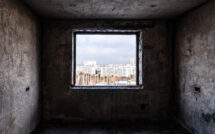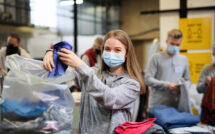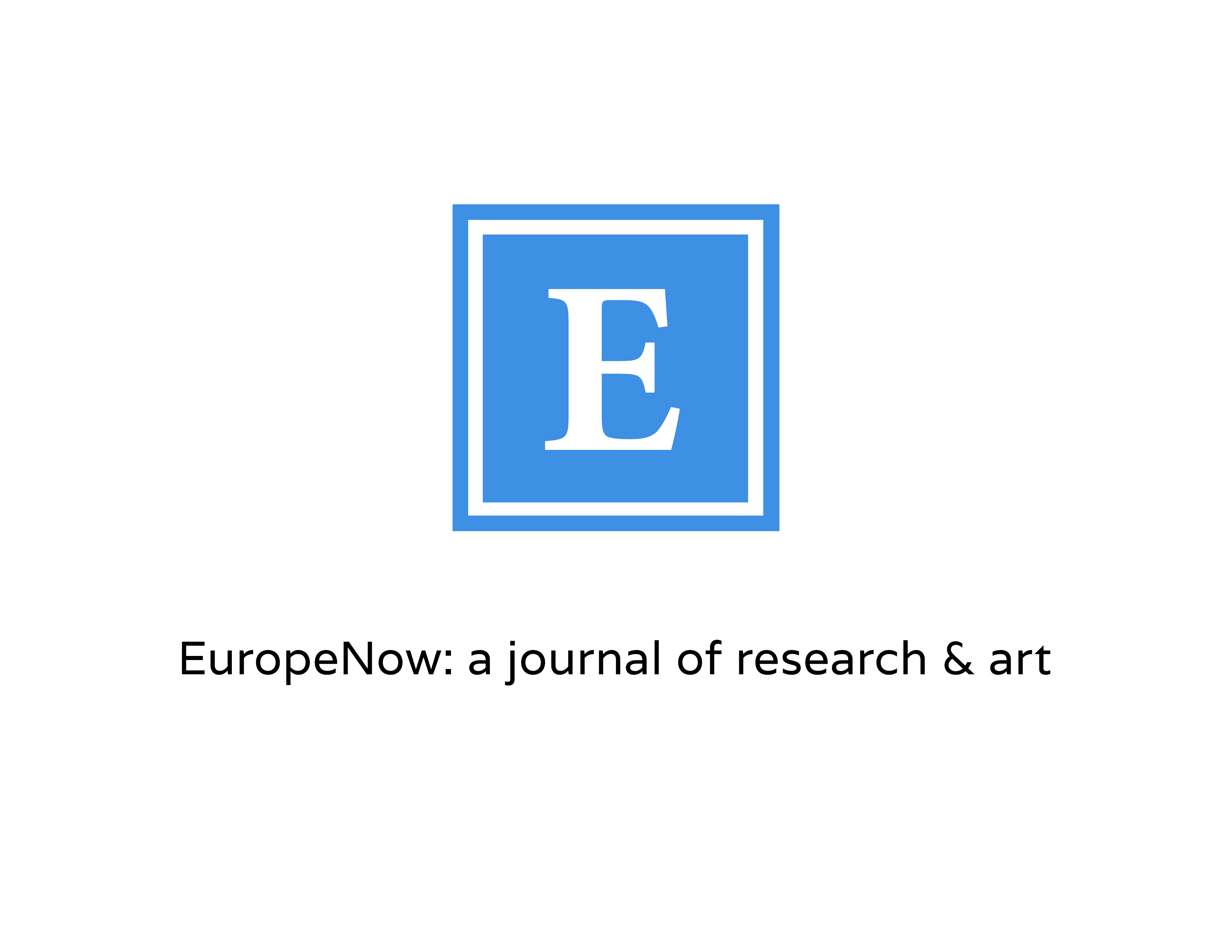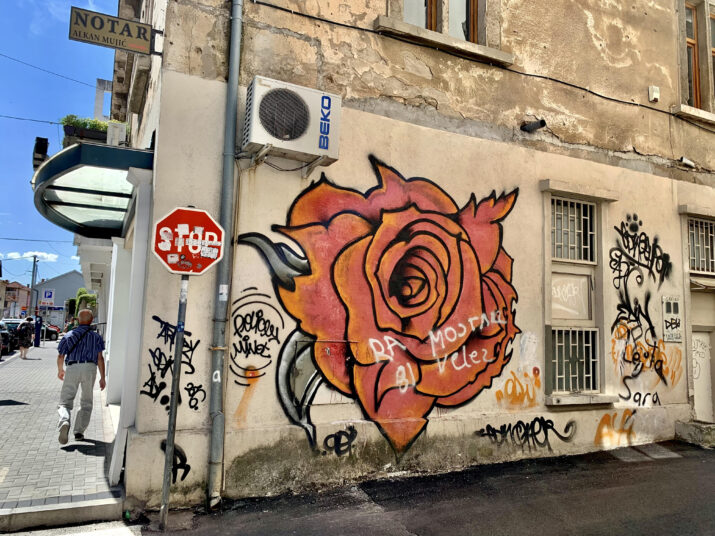
By Dina Greenberg
As a lifelong “creative” I find inspiration everywhere. My mind toggles freely between visual images and words on the page or the screen. And when it comes time for me to synthesize thought, research, experience, and emotion into a cohesive narrative, I often feel compelled to choose between “words” and “images” to convey a compelling story. In recent times, though, I find myself leaning into a more natural inclination to combine the two. I love the freedom this choice affords me. Street art—in its infinite array of styles and content—is emblematic of this hybridized creative medium. I’m not surprised to find myself drawn to these works like a bee to pollen.
Impetus
For over a decade, my work has focused on elevating the voices of women displaced by the 1990s wars in the former Yugoslavia. In published interviews with these women, the text is accompanied by images: rare photos of childhoods truncated by the trauma of war; photographs depicting family homes razed by enemy forces; snapshots capturing the smiles of loved ones—years or perhaps weeks or even days—before unspeakable horrors had been visited upon them.
Bosnia and Herzegovina
The book launch for my 2021 novel Nermina’s Chance, about the war in Bosnia and Herzegovina (BiH), precipitated a country-wide tour the summer of 2022. In each of the cities and small villages I visited, remnants of war—in the form of crumbling and bullet-riddled buildings—served as reminders of the recent past, even as new schools, condos, and office towers had filled the landscape.
A second trip in 2024 to BiH and Croatia for research on a new book of historical fiction yielded an unexpected benefit. When I reviewed the photos of street art I’d taken over the course of both trips, I discovered an uncanny overlap in the themes I often explore in my prose and poetry.
Primarily, the images underscored my core belief in the universal human need to recount our stories to others, to find solace and agency in the sharing—even (and especially) in the aftermath of trauma. These images compel us to examine the physical, emotional, and spiritual scars of war. In doing so, they help us to make meaning of unfathomable loss. They help us to heal, individually and communally, to imagine—as their creators have—a brighter future.
These works are statements of protest, commemoration, and activism, daring us to see into and beyond the images and words before us, to interpret the messaging as we choose. My guess is that, like me, viewers will find among these works, expressions of resilience and hope, playfulness, and irony. Art inspired by horror. Art inspired by beauty. Art wielded with the sole intention of inspiring joy.
Please note, I have tried whenever possible to include artist credits and contact information for the works.
Rijeka, Croatia
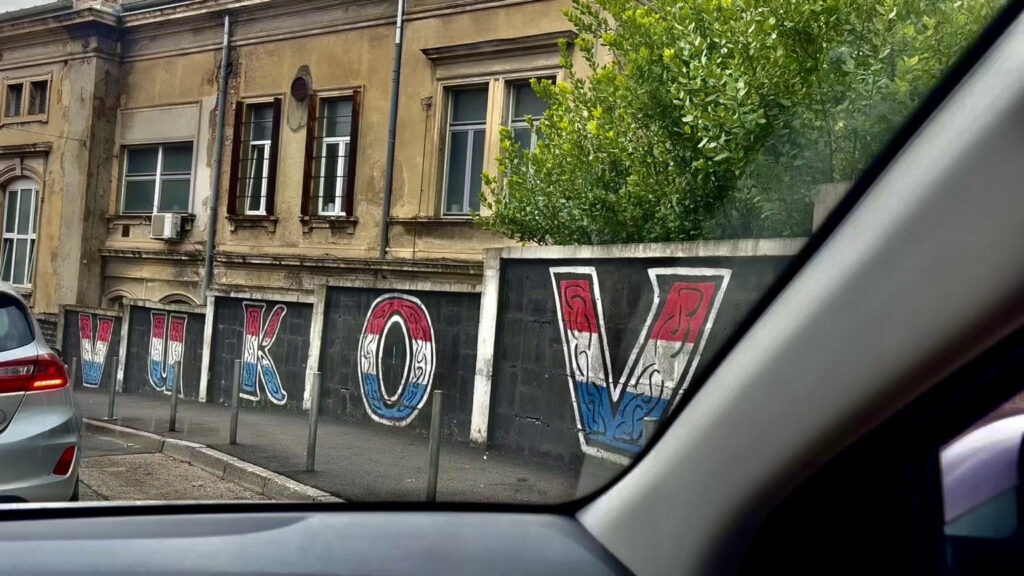
Artist(s) Unknown

Artist(s) Unknown
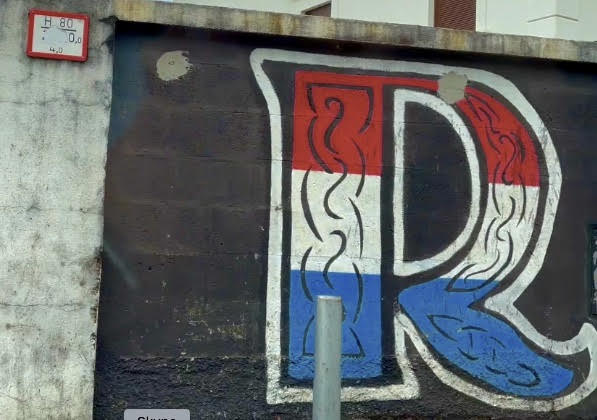
Artist(s) Unknown
I visited Rijeka in August 2024 after spending several days in Split. Though less of a tourist draw than the latter, this busy port city has its share of impressive Austro-Hungarian architecture. Most striking to me, however, was this commemorative mural to the 200 Croat and non-Serb civilians murdered in November 1991 by Serb forces, following a three-month siege on the city of Vukovar. For an exhaustive study of the atrocities carried out here and the decades-long efforts to bring the perpetrators to justice, read BIRN’s 2020 report.
Mostar, Bosnia
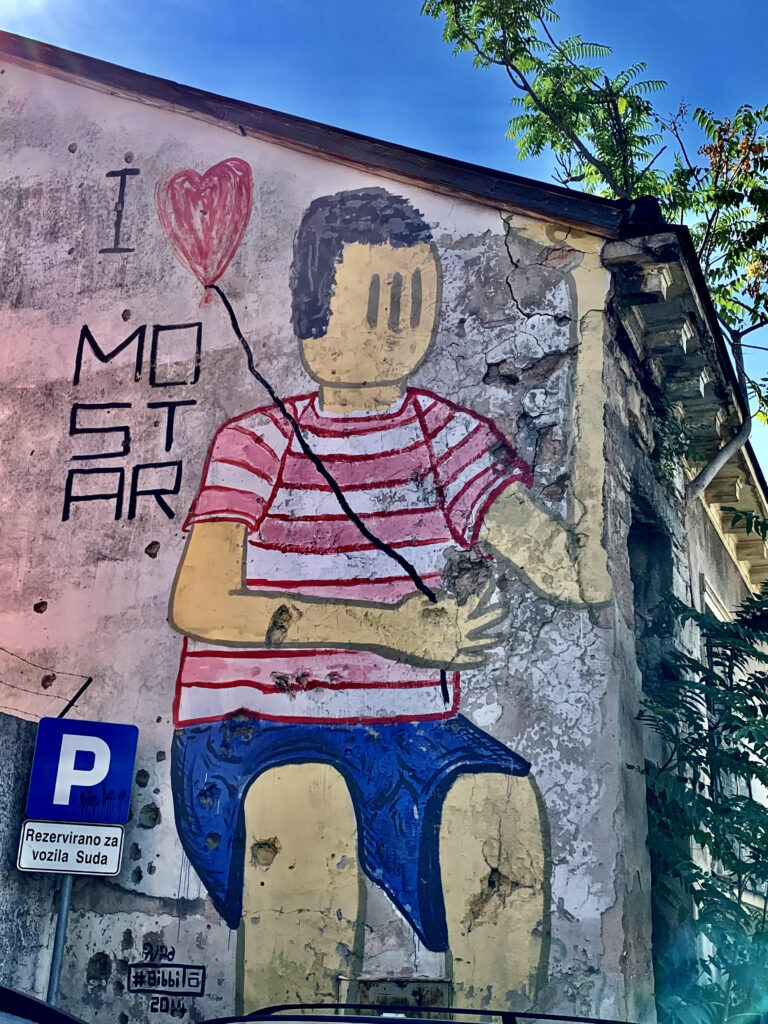
Artist: Bibbito, 2014
Mostar is one of Bosnia’s most picturesque cities, which makes it that much more gut-wrenching to know the magnificent Stari Most “Old Bridge” had been obliterated in the war. The reconstructed bridge is now “a symbol of reconciliation, international cooperation, and of the coexistence of diverse cultural, ethnic, and religious communities,” according to UNESCO.
I took this photo of Bibbito’s I Love Mostar mural in 2022. I later learned that Mostar holds an annual street art festival. Founded by Marina Mimoza, the inaugural event launched in 2012. SAFMO’s installations are concentrated on and around Alekse Šantića Street, the dividing line of the 1990s’ war. To view the now extensive array of Mostar’s street art treasures, visit Kami’s blog. To read about the impetus for and growth of the festival, read The New Berlin of the Balkans. For more of Bibbito’s work, view on Instagram.
Mostar, Bosnia
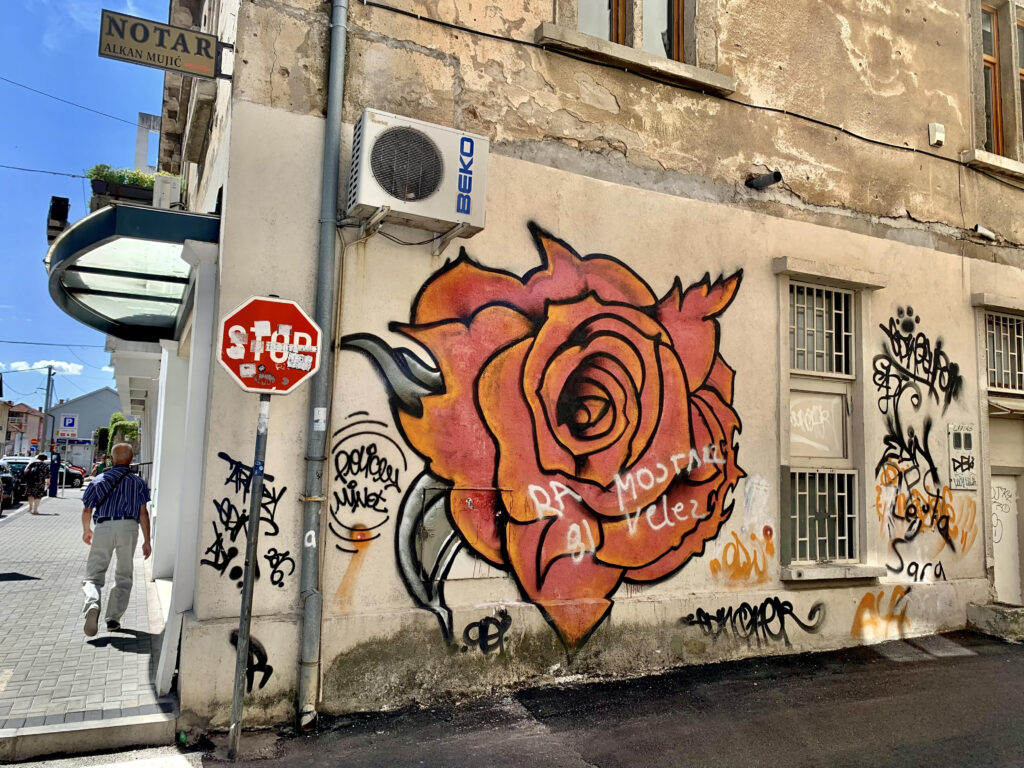
This image caught my attention during my visit in 2022. The rose called to mind what are known as “Sarajevo roses,” bullet holes in roads and sidewalks, running with the blood of the fallen. These images marked places where victims had been gunned down by Serb snipers, stationed in the hills surrounding the city during the 1,425-day siege of Sarajevo. I scrutinized the composition of the photo I’d taken here in Mostar, looking to identify the artist(s). Unfortunately, I came up short on my search. I was also completely wrong in my interpretation of the image.
I learned instead that the rose represents the soccer (football) fan club, “Red Army Mostar” (RA), founded in 1981 after FK Velež Mostar won its first Yugoslav World Cup. (The group’s Instagram is relatively sparse.) Since the club is made up primarily of Bosniak (Bosnian Muslim) fans, it would be meaningful to know when the mural was created and if it was conceived as a form of protest against the war.
Split, Croatia
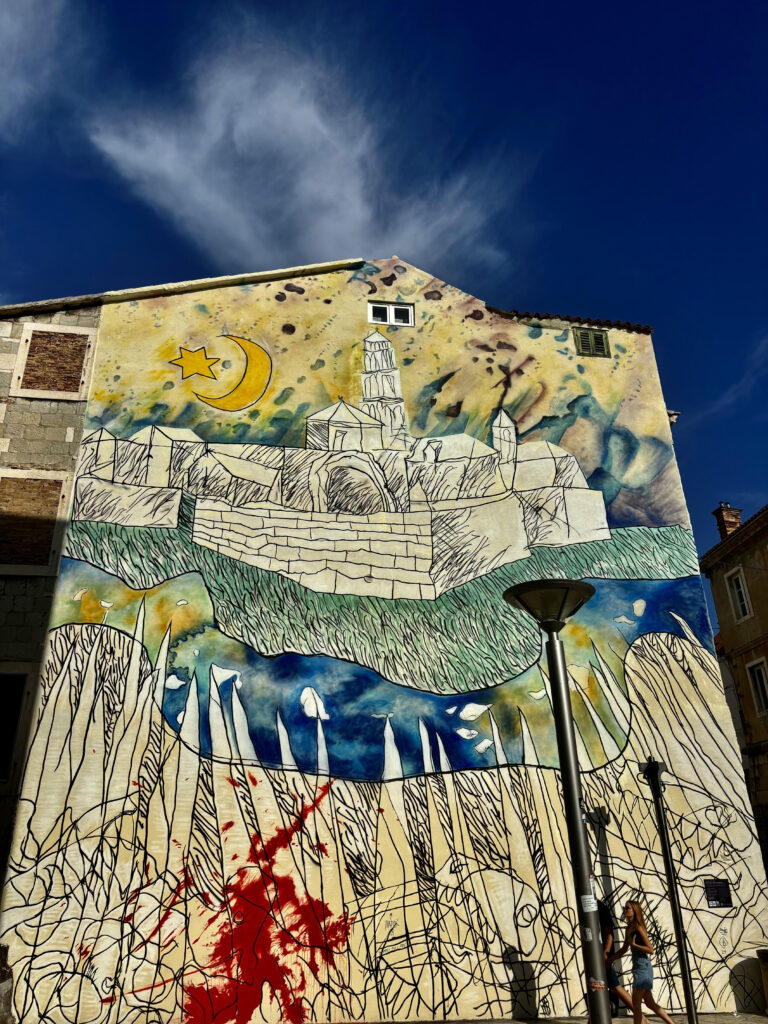
I took photos of several murals by Ivan Svagusa Stripovi (SVAIGE) and Luka Duolančić in August 2024. The first, a mural depicting Matko Trebotic’s painting: Opsada Betulija (The Siege of Julia), stunned me in its scope and composition. And that was before I understood the importance of this work, the artists’ equivalent of a play-within-a-play where each artist honors the origin of a former creation, even as they add another iteration and their own spin on the underlying subject.
The mural was created to commemorate the 500-year anniversary of Croatian poet, humanist, and scholar, Marko Marulić’s, death. Perhaps his most famous, the religious epic poem “Judita,” published in 1521, was inspired by the Old Testament and events of the Ottoman incursion into Croat lands. To view more works by SVAIGE, visit his Instagram. To view more by Luka Duolančić visit his Instagram
Split, Croatia
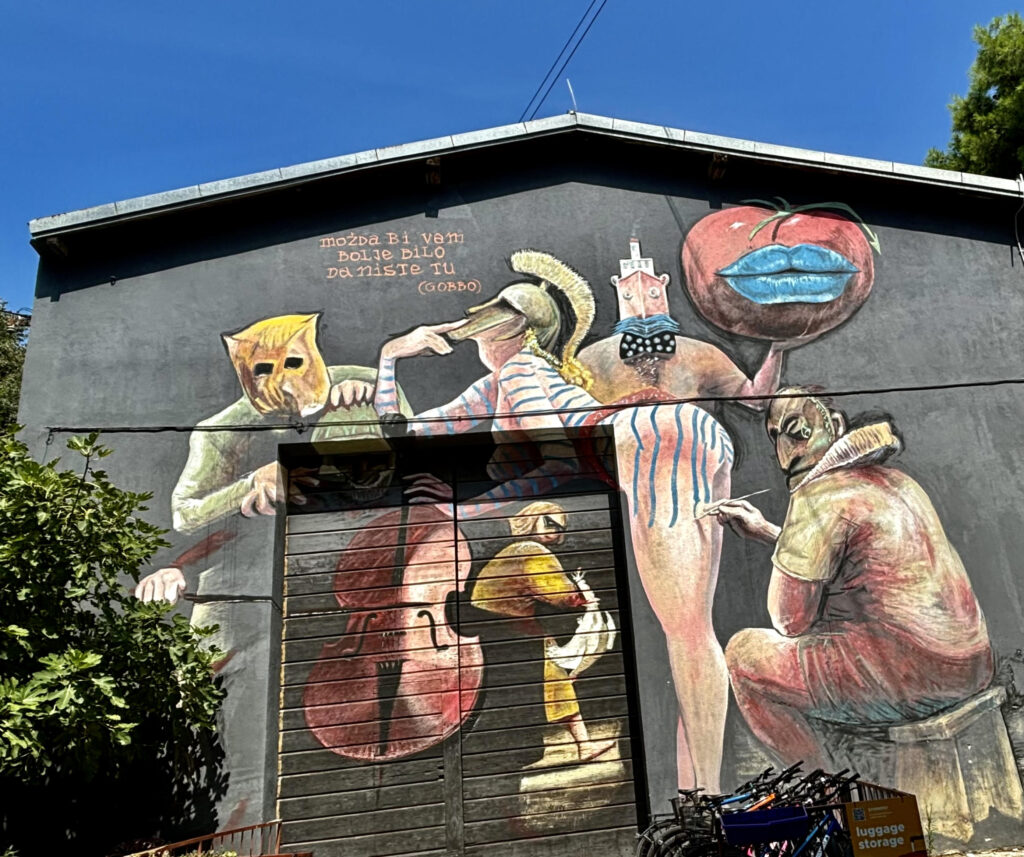
Maybe it Would Be Better if You Weren’t Here
Artists: Ivan Svagusa Stripovi (SVAIGE) and Luka Duolančić (2022)
This mural, entitled “Maybe it Would be better if You Weren’t Here” is based on the illustration by Alem Ćurin and was also used for the poster of the 48th Split Summer festival several years ago. The mural was inaugurated in 2022 during the 66th edition of the Split Summer festival. I love how equal measures of playfulness and irony remind viewers like me to find humor wherever and whenever possible.
Split, Croatia
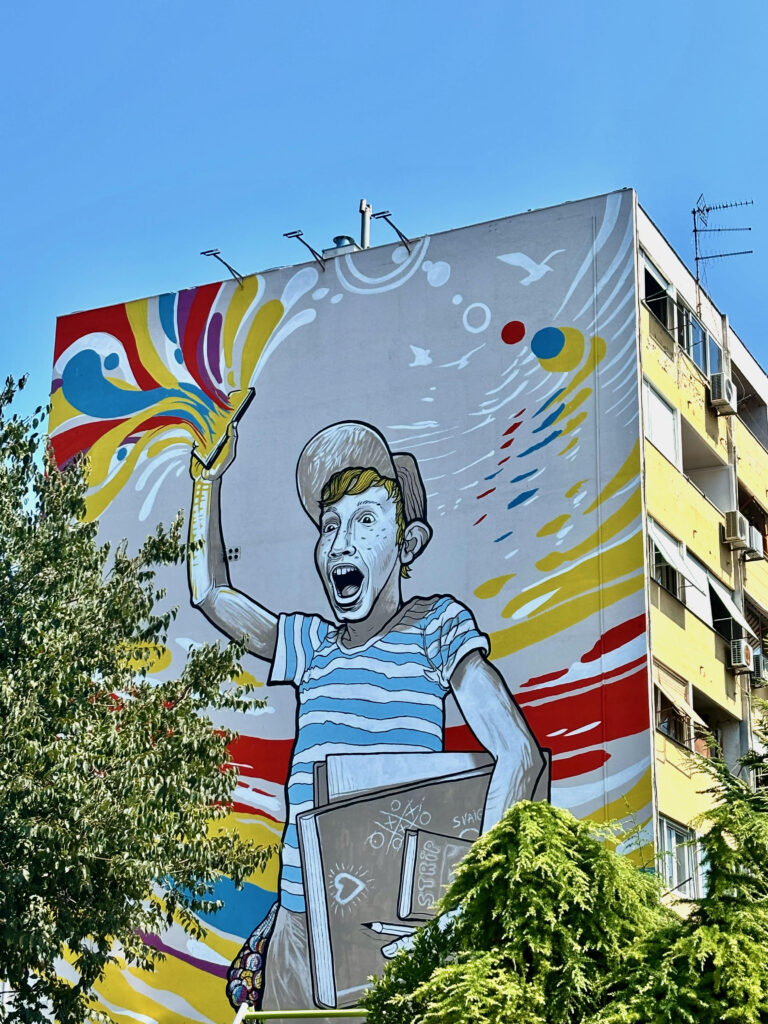
I happened upon this mural in one of Split’s residential neighborhoods. The subject matter and energy of this piece blend imperceptibly with the vibrancy of the city, juxtaposing the old and the new. I don’t know its title, but have dubbed it “Happy Cell Phone Boy.” For an extraordinary romp through Split’s street art, visit here.
Split, Croatia
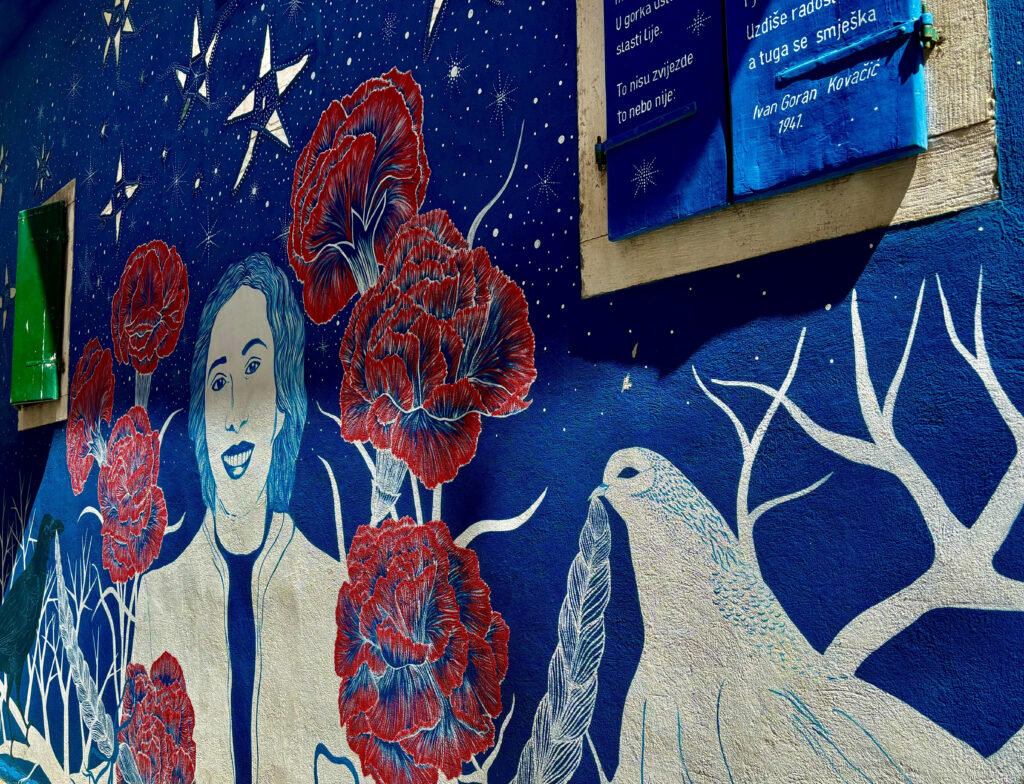
Inset “Noc” for poet, Croatian Partisan, Ivan Goran Kovačić (1913 –1943)
Artist: Andrea Resner
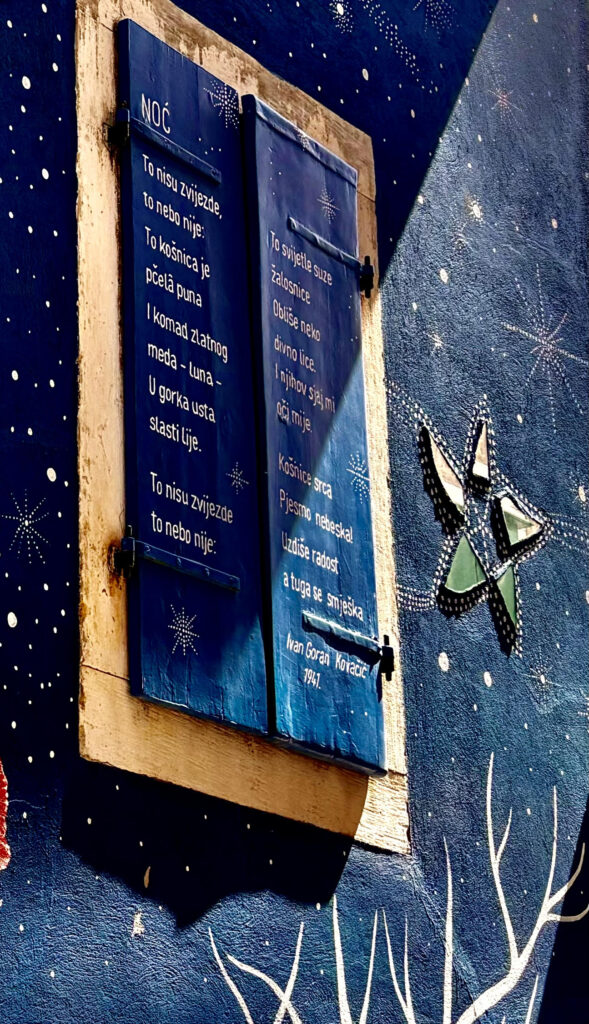
Inset “Noc” for poet, Croatian Partisan, Ivan Goran Kovačić (1913 –1943)
Artist: Andrea Resner
The cheerful cerulean blue background of Andrea Resner’s mural drew me in immediately, the brilliance of the color belying the tragic end of its young subject. This piece commemorates the little-known Croatian anti-fascist Palmina Piplović (1922-1944), who was executed by German officers during World War II. The mural resides in the heart of Split’s Veli Varoš neighborhood, where the Piplović family once lived. It is encouraging to see this memorial to a female Partisan (resistance fighter), even if only as an anomaly.
The poem “Noć” (transcribed on the window shutter) was penned in 1941 by poet and fellow Croatian Partisan, Ivan Goran Kovačić (1913-1943). For Croatian speakers, the poem appears here. I was unable to find a proper English or Spanish translation.
Split, Croatia
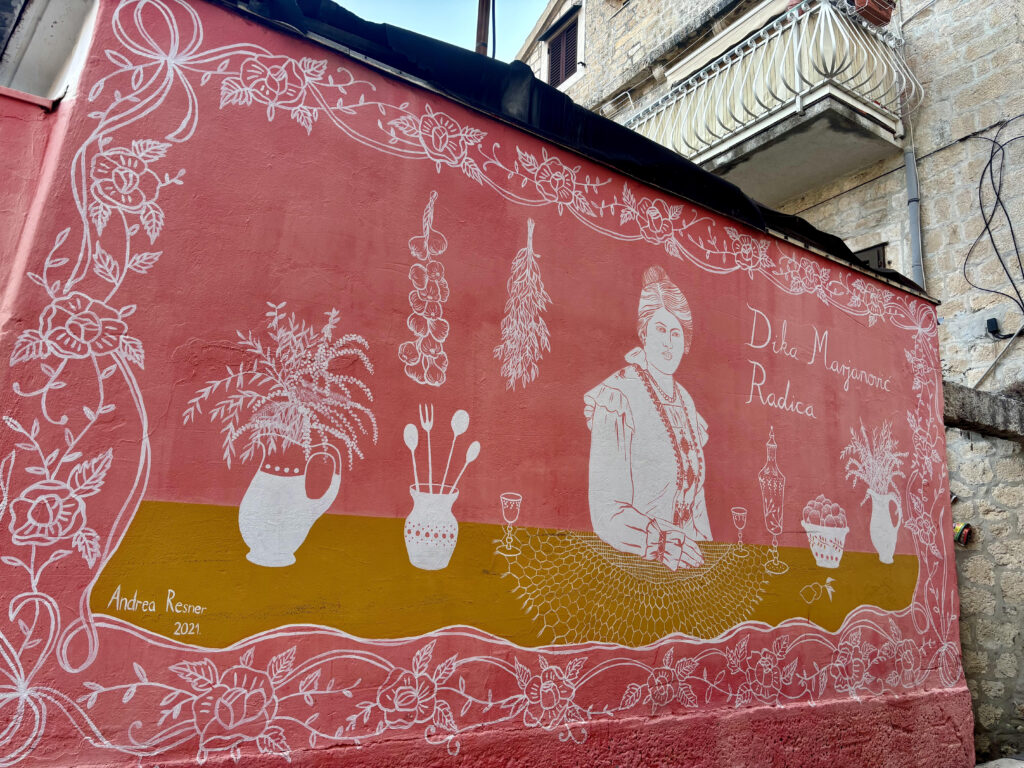
Artist: Andrea Resner
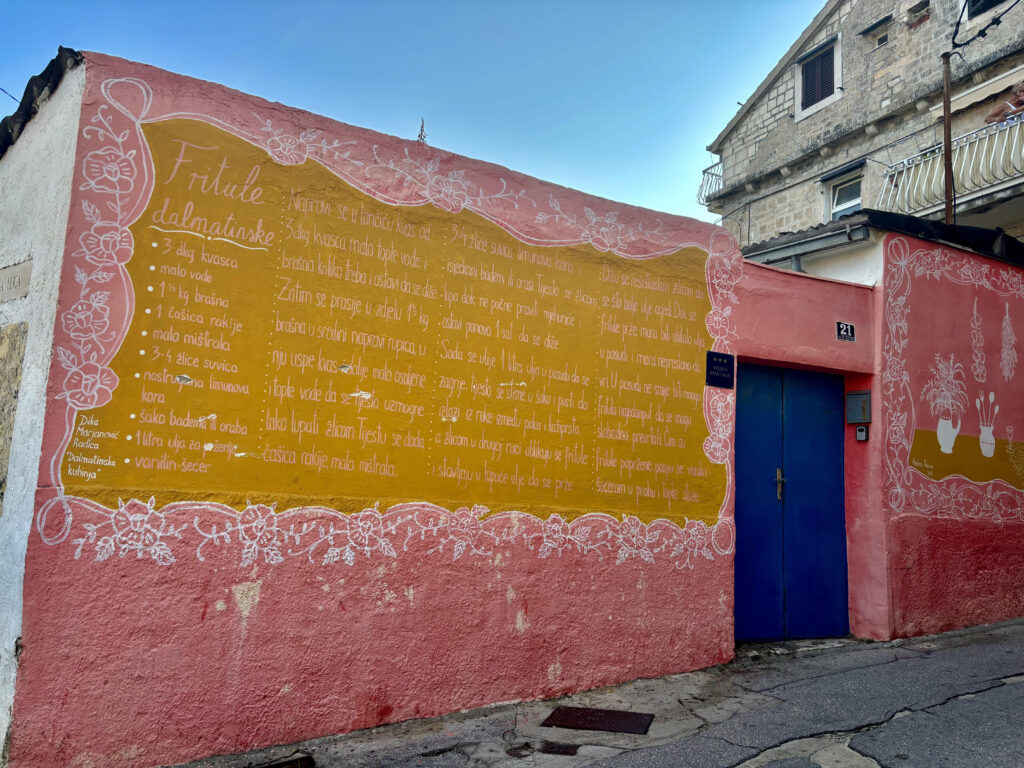
Artist: Andrea Resner
Andrea Resner created this mural as a loving memorial to Dika Marjanović Radica (1892-1984). “Dika” is known as the woman who preserved the culinary traditions and folk heritage of Dalmatian cuisine and one of Croatia’s most popular cooks. Again, for Croatian speakers, Resner’s mural even includes a recipe for Fritule Dalmantinske (Dalmatian fritters).
Zenica, Bosnia
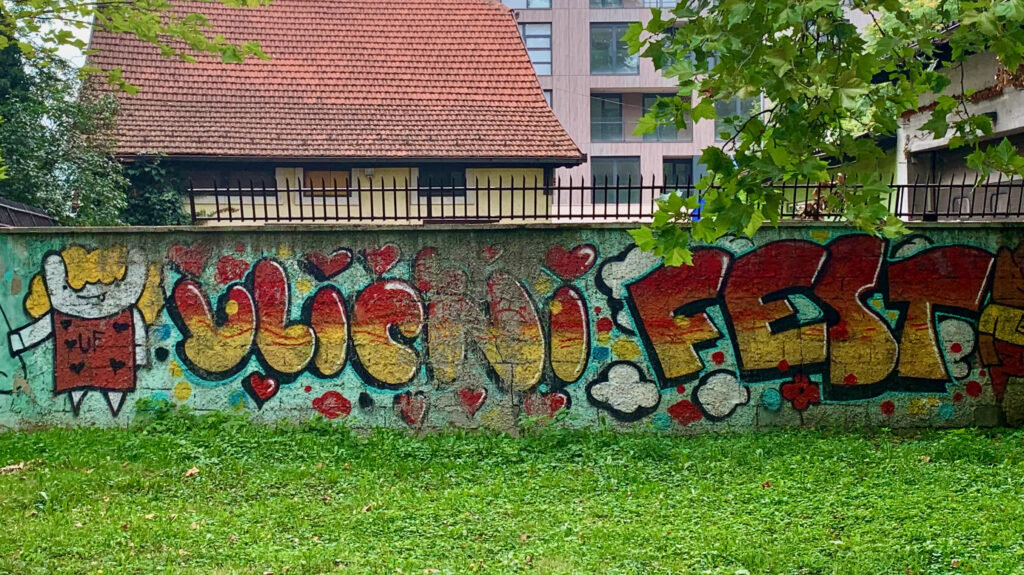
Artist(s) Unknown
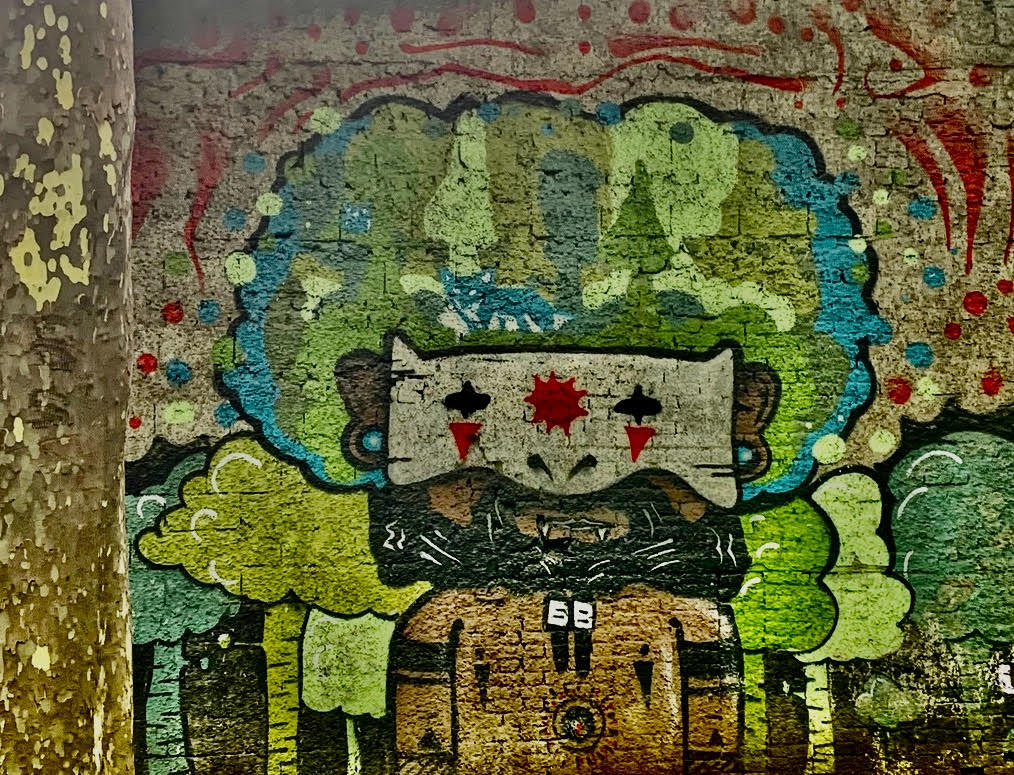
Artist: Haris Turalić, 2017
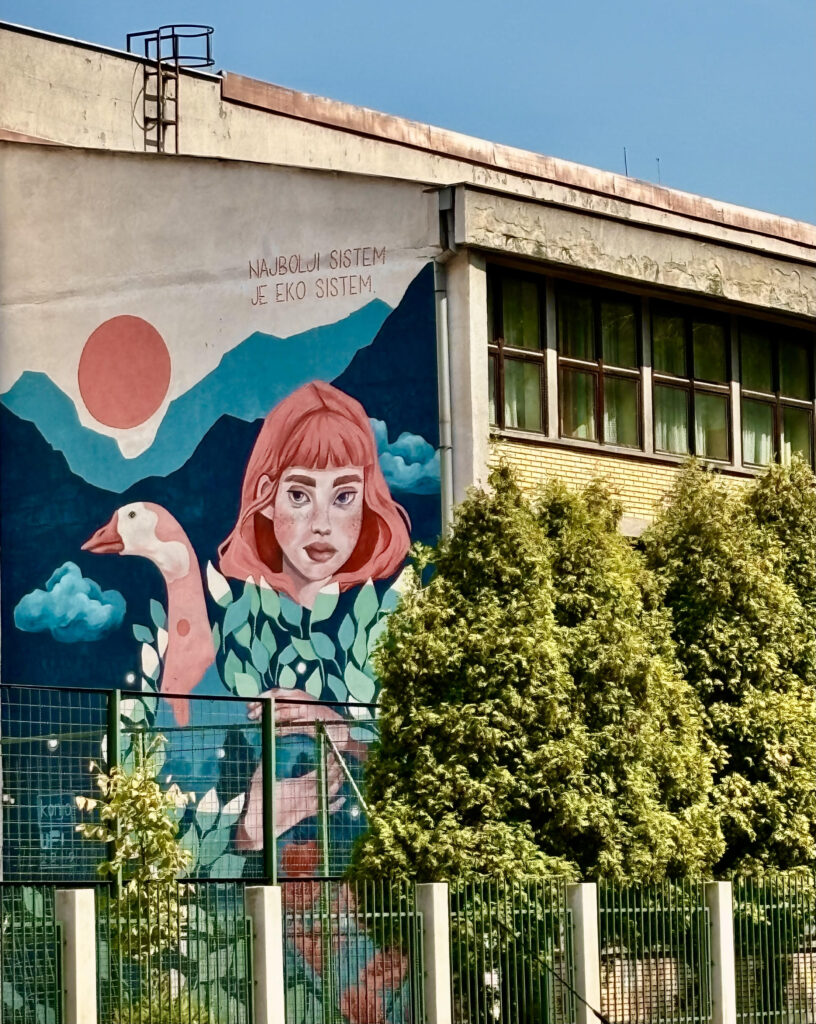
The Best System is the Eco System
Artist: Nataša Konjević, 2019
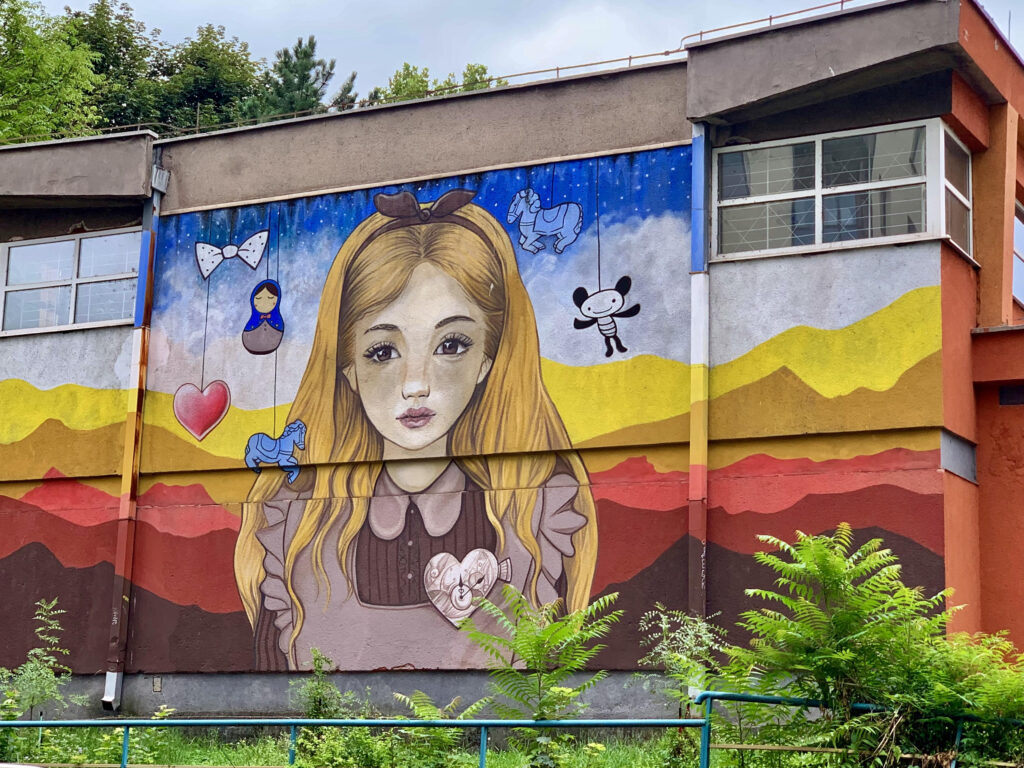
I visited Zenica in 2022 and then again in 2024. Both times, I was impressed with examples of street art that seemed to appear around every corner. I only learned about the city’s Ulični Festival Zenica when I began research for this photo-essay.
It was encouraging to learn how young people here envision their role as change-makers, prompting us to imagine a cleaner environment, better schools, and a world honoring the values of inclusion, diversity, and the arts. I found it especially interesting, and somewhat disturbing, though, to learn that Zorana Unković’s 2017 mural had been painted over for reasons I don’t completely understand. This instance, however, speaks to the volatility of public art and the inherent tension between the artists, municipal governments, residents, and local business owners.
Sarajevo, Bosnia
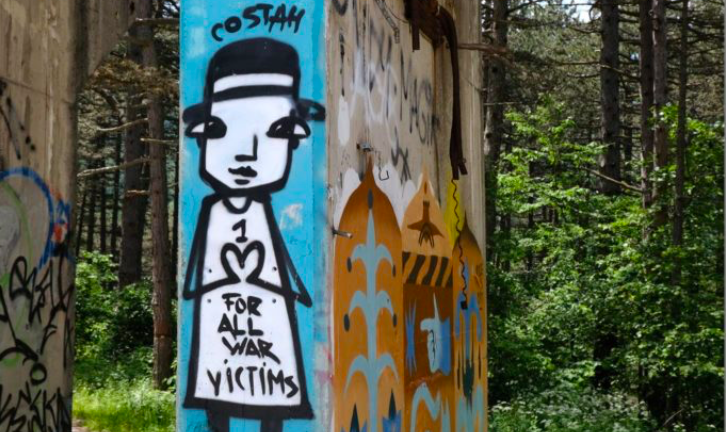
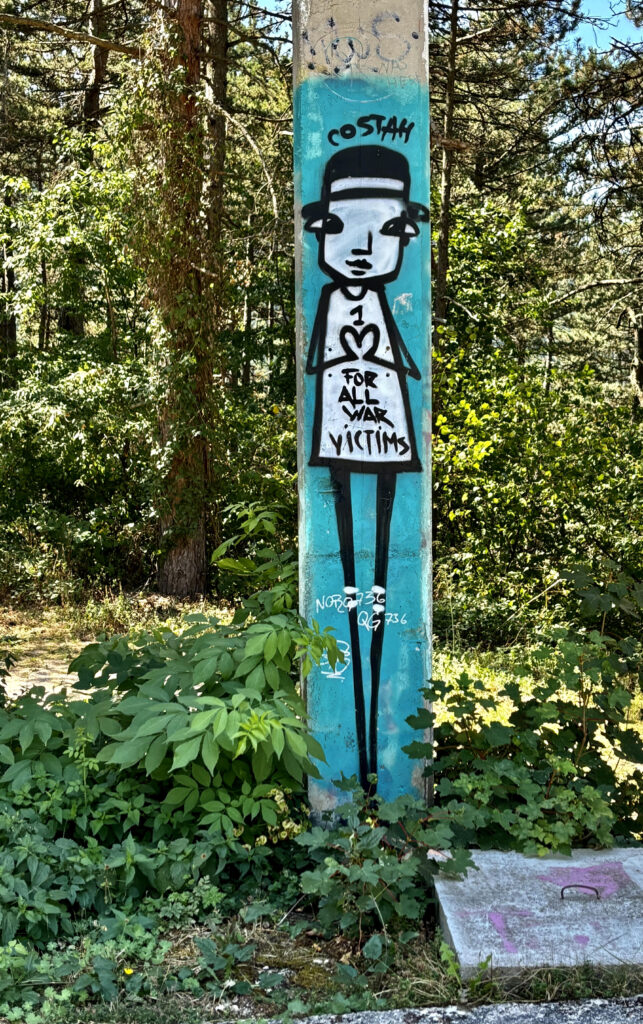
I took a serendipitous trip to Mount Trebević, high above Sarajevo, and home to many events of the 1984 Winter Olympic Games. Without the insistence of a local friend, I would likely have missed this incredible spot. Aside from miles of trails and the natural beauty of this reclaimed space, street artists have turned the former Olympic bobsled run into an epic work of communal art. This piece by Nuno Costah stood out to me in its poignant simplicity. Sadly, the message is one that continues to resonate from decade to decade and century to century. It seems, there will always be victims of war. For an exceptional collection of photos of the works here, visit photographer Anna Kasperiewicz’s site.
Sarajevo, Bosnia

Artist(s) Unknown
Out of the dozens of photos I took at Trebević, I just loved the goofy smile the artist depicts here. When I searched for the tag’s owner, though, I hit a brick—or rather, concrete—wall.
Sarajevo, Bosnia
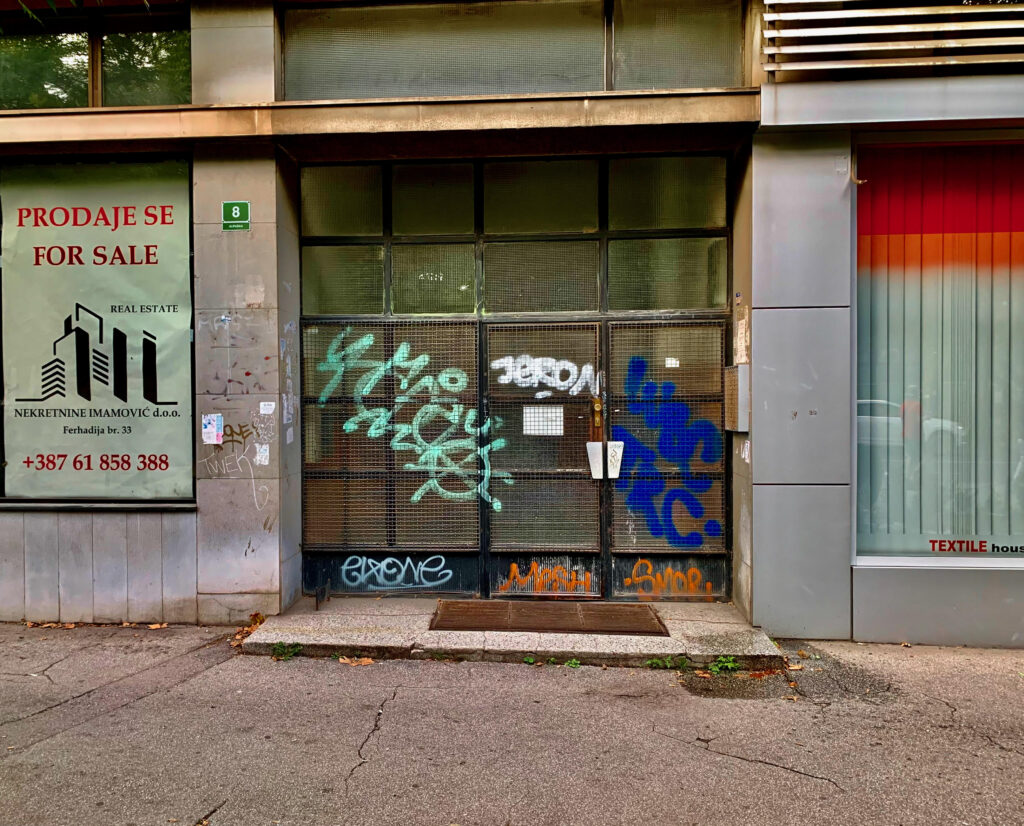
Artist(s) Unknown
I named this graffiti “For Sale: 8 Alipisina.” In August-September 2022, an apartment on this block served as a home base for my stay in Bosnia. While graffiti can be off-putting—I imagine, especially so to residential and commercial real estate owners—it continues to be a ubiquitous form of artistic expression. In this case, I saw a perfectly articulated, head-to-head battle between the graffiti art and the (official) printed notice in the window.
Sarajevo, Bosnia
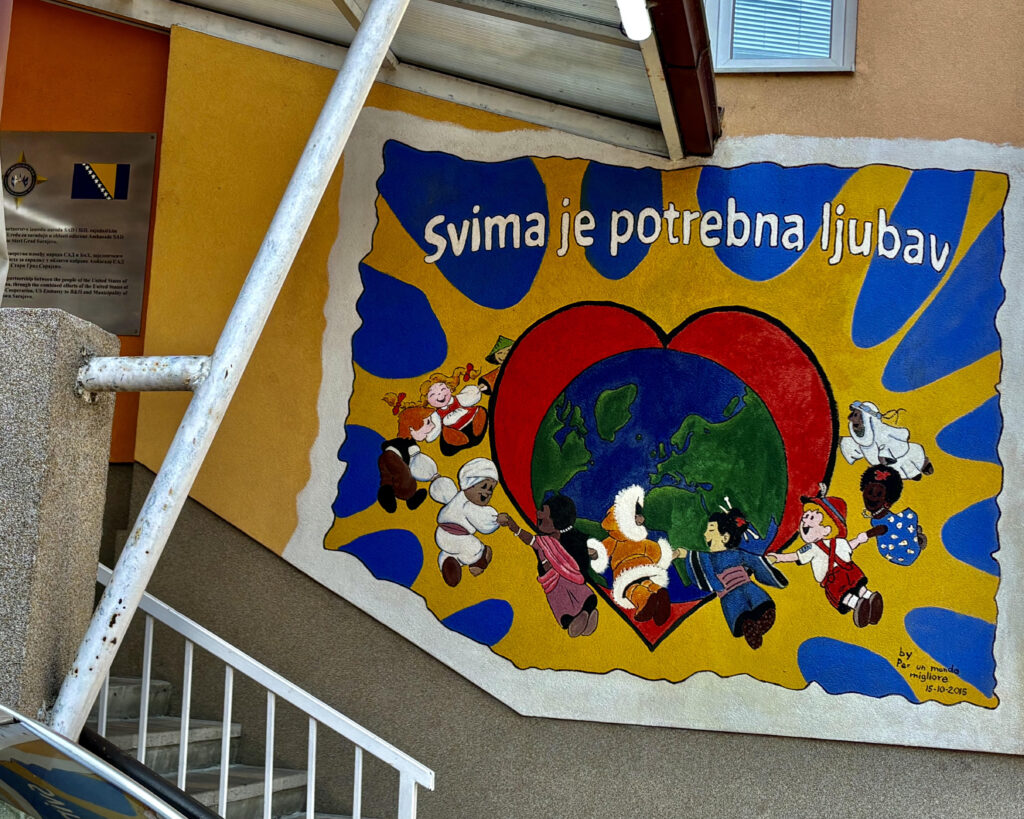
Artist)s) Unknown
This whimsical piece appears at the entrance to a Sarajevo elementary school. I love the depiction of our world as a place of intercultural harmony. Bosnia—and Sarajevo in particular—was such a place before the war, and remains so today. However, the proliferation of revisionist history and drumbeat of secession, stoked by Republika Srpska leader Milorad Dodik, threatens a peaceful and prosperous future for Bosnia’s melting pot of ethnicities and religions.
Sarajevo, Bosnia
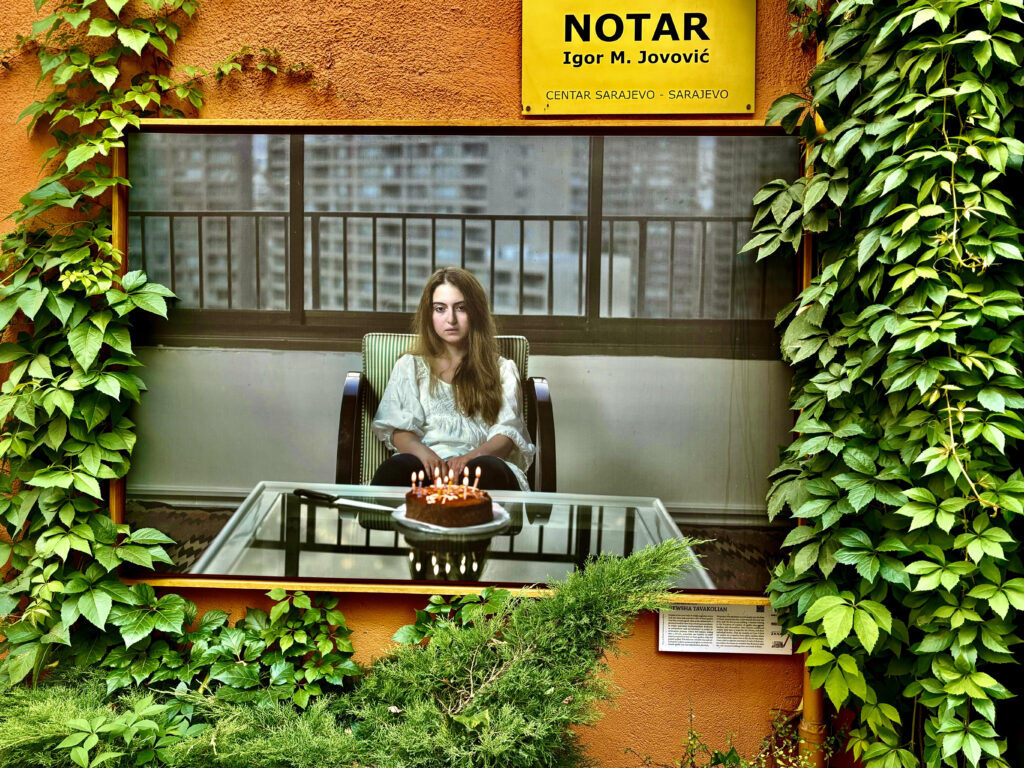
Photographer: Newsha Tavakolian, 2024
Iranian photographer and photojournalist Newsha Tavakolian created this piece as part of her series: “And They Laughed at Me” for the 2024 WARM Festival. The festival is dedicated to documenting contemporary conflicts through art. Tavakolian’s works appeared in fifteen locations throughout the city and at the Bosnian Cultural Center Sarajevo. When I first walked past this photograph, I did a double-take. The hyper-realism of the image caught me off guard, so much so that I saw a young woman peering out a window rather than the solid exterior wall of a notary’s office building.
Brčko, Bosnia
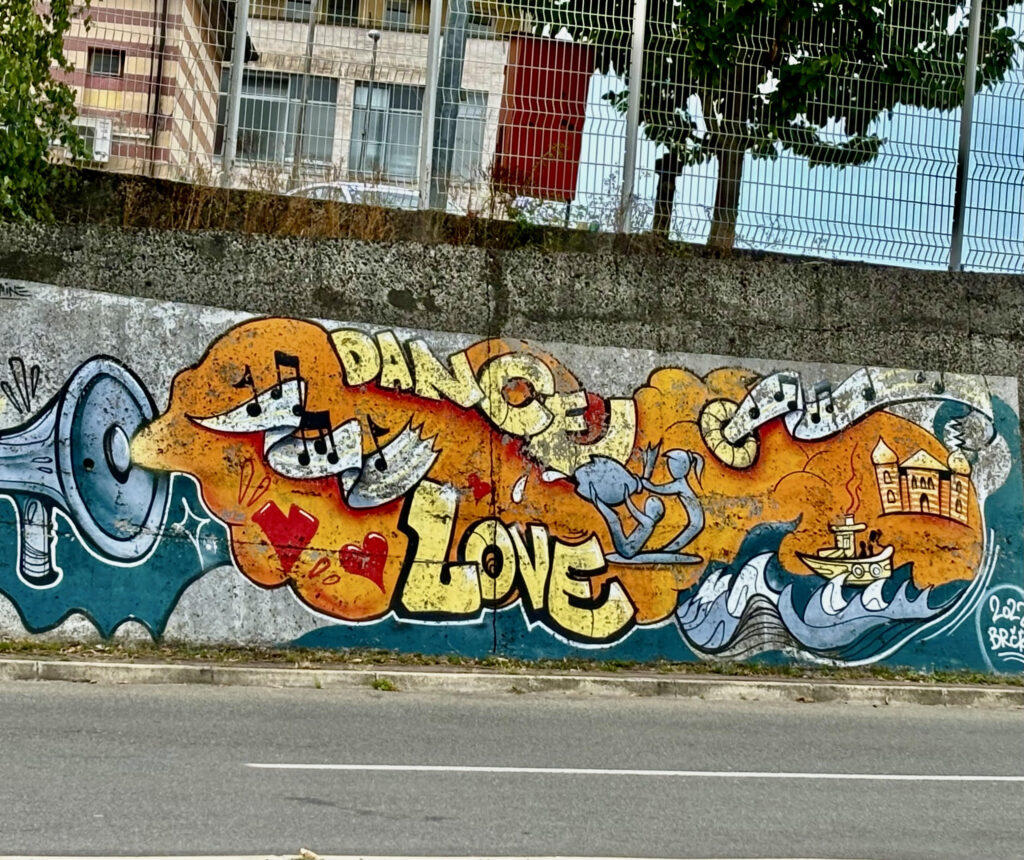
Following years of negotiations, in 1999 the Brčko District was established as an autonomous and multi-ethnic region in Bosnia. Here, rather than funneling children into schools divided by ethnicity (Muslim, Croat, and Serb), education, along with all other civic engagement, is trained on the goal of inclusion. This mural embodies the sense of hope I find in the people of this city, some who have become close friends and colleagues.
Zagreb, Croatia
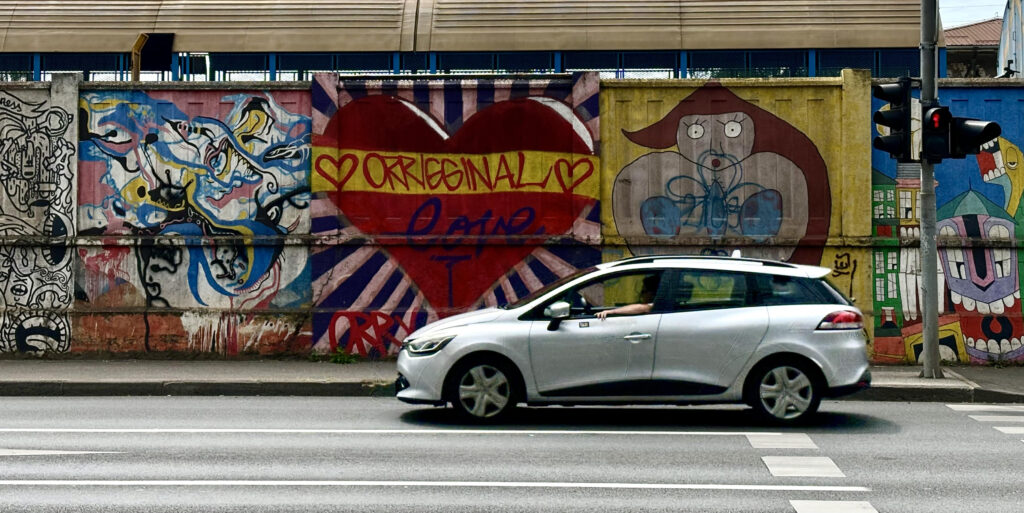
I didn’t get to spend nearly enough time in this beautiful city as I had hoped to. After 36 hours of a grueling travel nightmare enroute from the US to Croatia, this was the image that greeted me across from the hotel where I finally and happily crashed! It made me smile.
Ližnjan, Croatia
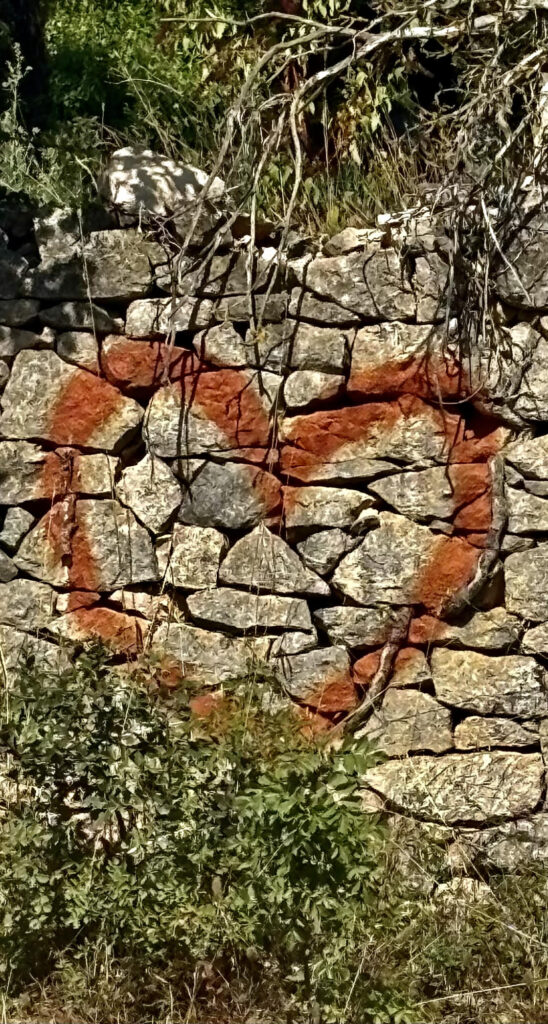
Finally, this simple expression of love appeared before me as I set out each morning from the lovely Zvoni I Nari Cultural Center, where I served as writer in residence this August. The people of Istria share a warmth that is unique and irrepressible. Whoever created this image has summed up perfectly a world view we would all do well to emulate.
Author Bio
Dina Greenberg
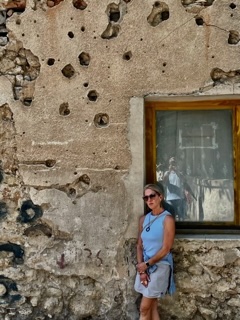
Over the course of my career, I’ve turned my expertise in trauma-informed writing toward elevating the voices of survivors of war and displacement. This work coalesced in the historical novel, Nermina’s Chance, a narrative exploring intergenerational trauma in the aftermath of war in 1990s Bosnia. Related projects include the interview series “Women of the Bosnian Diaspora;” research on the pre-World War II Jewish Community in Yugoslavia; and the novel-in-progress Ghosts are Falling, about two children living in the shadow of the Bosnian war. Prayers for the Lost & for the Living—a compilation of prose and poetry—was published by Sligo Creek Publishing ( April 2025).
I teach creative writing workshops in academic, community, and NGO settings, and in August 2024, I served as writer in residence at Zvona I Nari Cultural Center in Istria. In 2025 I was awarded a Fulbright US International Scholar Award to complete an oral history project in Kosovo entitled: CAPTURING JEWISH NARRATIVES OF KOSOVO: ORAL HISTORY AS LEGACY. I’ve also been awarded a writing residency at the Croatian Literary Translators Association in Zagreb.
Nominated for The Pushcart Prize, Best Small Fictions, and The Millions, my writing appears in international media outlets like Bosna Global and Sarajevo Times; and literary journals including: Bellevue Literary Review, Chautauqua, Tahoma Literary Review, Pembroke Magazine, and Split Rock Review. I hold an MFA in fiction from the University of North Carolina, Wilmington, and an MLS and BA in English from the University of Pennsylvania.

